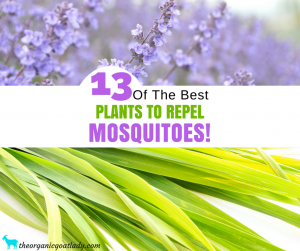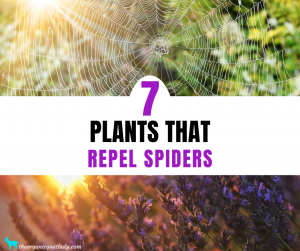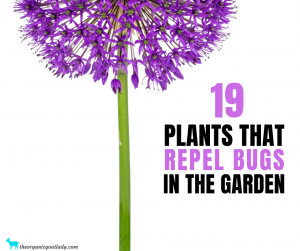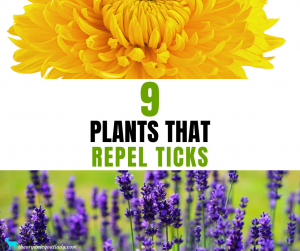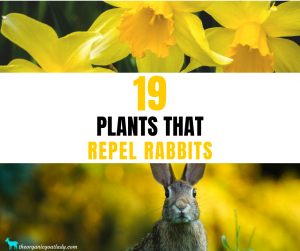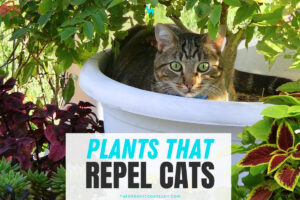Are you looking for a natural way to repel gnats? Are you wanting to find out what plants repel gnats? These plants will not only repel pesky insects but will look great in your flower beds or in your vegetable garden!
This site contains affiliate links. If you make a purchase using one of these links, I may earn a commission. Please click here for more information about cookies collected and our privacy policy.
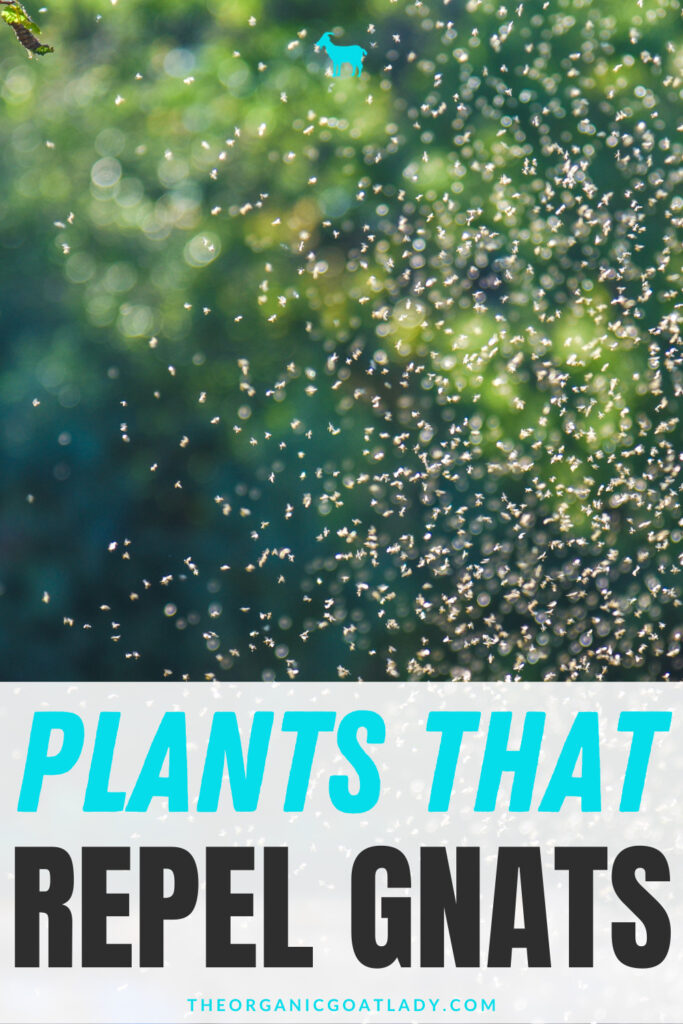
What Plants Repel Gnats?
Before we look at all of the plants that will help to repel gnats let’s look at what gnats are and the different types of gnats that can plague us!
What are Gnats?
Gnats are small, flying insects that belong to several different families within the order Diptera, which includes true flies. They are characterized by their slender bodies, long legs, and transparent wings. Gnats are known for their tiny size, typically ranging from 1 to 4 millimeters in length, although some species can be slightly larger.
They are considered pesky bugs and and are definitely something you will want to repel!
There are various types of gnats, and they can be found in different environments and habitats. Some common types of gnats include:
1. Fungus Gnats: These gnats are often found in damp, decaying organic matter and are known for infesting potted plants and mushroom-growing environments.
2. Fruit Flies: While not true gnats, fruit flies are often referred to as such. They are small insects that are attracted to overripe fruits and sugary substances.
3. Biting Gnats: These gnats include species like black flies and midges, which are known for their painful bites and are often found near bodies of water.
4. Sand Gnats: Also known as sand flies or no-see-ums, these tiny gnats are notorious for their itchy bites and are commonly found in sandy or coastal areas.
5. Eye Gnats: These gnats are attracted to the moisture around the eyes, nose, and mouth of animals and humans, which can be irritating.
Gnats are primarily herbivorous or feed on decaying organic matter. They are often considered nuisance pests, especially when they infest homes, gardens, or outdoor gathering areas. While many species of gnats are harmless, some can transmit diseases or cause allergic reactions through their bites.
Types of Plants for Natural Gnat Repellent
There are multiple plants that can help repel gnats and other flying insects due to their natural fragrances and properties.
Here are some plants known to be effective at repelling gnats:
1. Lavender: Gnats and other flying insects are often repelled by the strong scent of the lavender plant.
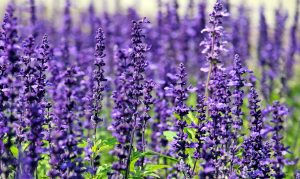
Here’s how you can use lavender plants to help deter gnats:
1. Plant Lavender in Your Garden: Consider planting lavender in your garden or yard, particularly in areas where you spend time outdoors. Lavender’s natural scent will help keep gnats at bay. Make sure to choose a sunny location with well-drained soil for your lavender plants.
2. Create a Lavender Border: Planting a border of lavender around your outdoor seating or dining area can act as a natural barrier to keep gnats and other flying insects away from you and your guests.
3. Potted Lavender: If you don’t have space for a garden, you can still enjoy the benefits of lavender by growing it in pots. Place potted lavender plants on your patio, balcony, or near outdoor entrances to help repel gnats.
4. Harvest and Dry Lavender: Harvesting and drying lavender flowers can provide you with dried lavender sachets or bundles that you can place in various areas to repel gnats indoors. Hang them in closets, place them near windows, or tuck them under pillows to enjoy the fragrance while keeping gnats away.
5. Lavender Essential Oil: You can also use lavender oil to create DIY gnat-repelling sprays. You can find a great insect repellent spray here.
Keep in mind that while lavender is effective at repelling gnats, its effectiveness may vary depending on factors like the species of gnats and the local environment. Combining lavender with other gnat-repelling plants and methods, as mentioned in previous responses, can provide more comprehensive protection against these pests.
2. Citronella: Citronella plants, often referred to as “citronella scented geraniums” or “mosquito plants,” are popular choices for repelling not only the mosquito population but also gnats and other flying insects.
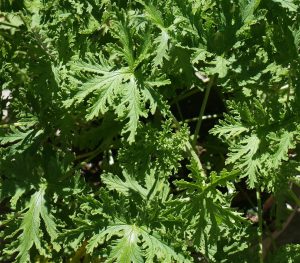
Here’s how you can use citronella plants to help repel gnats:
1. Plant Citronella in Your Garden: Citronella grass is typically grown as ornamental perennials in many regions. Plant them in your garden or yard to help create a natural barrier that deters gnats and other flying insects.
2. Potted Citronella Plants: If you have limited space or want to use citronella plants on patios, balconies, or near outdoor seating areas, you can grow them in pots. Place the potted citronella plants strategically to keep gnats away from your outdoor living spaces.
3. Crush the Leaves: Citronella plants release their mosquito-repelling fragrance when their leaves are crushed or brushed against. By gently crushing or rubbing the leaves, you can release the scent and help repel gnats and other insects in the area.
4. Essential Oils: Citronella oil, extracted from the citronella plant, can be used to make DIY gnat-repelling sprays. Get the recipe or a great Insect Repellent here.
5. Citronella Candles: Citronella candles and torches are widely available and can be placed around outdoor seating areas to create a protective barrier of scent that discourages gnats and other flying insects from approaching.
6. Citronella Incense: Citronella incense sticks or coils can also be used to repel gnats and other pests during outdoor activities. Place them in appropriate holders around your outdoor space.
7. Citronella Potpourri: Create potpourri using dried citronella leaves and flowers, or mix citronella leaves with other dried herbs and flowers. Display this potpourri in bowls around your home to deter gnats and enjoy a pleasant fragrance.
It’s worth noting that while citronella is effective at repelling gnats and mosquitoes, its effectiveness may vary depending on the specific species of gnats and the environmental conditions. Combining citronella with other gnat-repelling plants and methods, as mentioned above, can enhance your overall pest control efforts.
3. Rosemary: Rosemary is a fragrant herb that is known for its culinary uses as well as its ability to repel gnats and other flying insects due to its strong aroma.
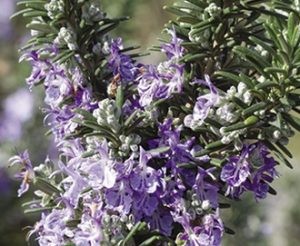
Here’s how you can use rosemary plants to help deter gnats:
1. Plant Rosemary in Your Garden: Rosemary is a hardy herb that can be planted in your garden or yard. Its aromatic foliage will help keep gnats away from the area where it’s planted. Ensure it gets plenty of sunlight and well-drained soil.
2. Potted Rosemary Plants: If you have limited garden space, grow rosemary in pots or containers. Place these potted plants on your patio, balcony, or near outdoor seating areas to help repel gnats.
3. Crush the Leaves: Like citronella, rosemary plants release their scent when their leaves are crushed or brushed against. To release the fragrance and enhance its gnat-repelling properties, gently crush or rub the leaves.
4. Rosemary Essential Oil: You can use rosemary essential oil to make your own gnat-repelling sprays or diffuse essential oils to keep an area gnat free.
5. Rosemary Bundles: Create bundles of fresh rosemary sprigs and hang them in outdoor areas. These bundles can serve as natural gnat repellents and also add a decorative touch to your outdoor space.
6. Rosemary Smoke: If you have a barbecue or fire pit in your outdoor area, adding rosemary branches to the fire can release the scent and help deter gnats while you enjoy outdoor activities.
7. Rosemary Potpourri: Make potpourri using dried rosemary leaves and flowers, or mix dried rosemary with other aromatic herbs and flowers. Display the potpourri in bowls indoors or on outdoor tables to repel gnats and add fragrance.
Rosemary is an attractive and versatile plant that can be a valuable addition to your garden or outdoor living spaces, not only for its pest-repelling qualities but also for its culinary uses and aromatic appeal. Combining rosemary with other gnat-repelling plants and methods can provide comprehensive protection against gnats and other flying insects.
4. Basil: The basil plant is a fragrant herb that is primarily grown for culinary purposes, but it also has properties that can help repel gnats and other flying insects.
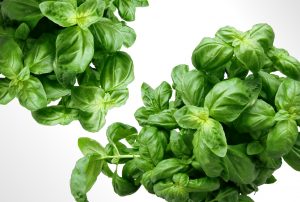
Here’s how you can use this popular herb to help deter gnats:
1. Plant Basil in Your Garden: Basil is easy to grow and can be planted in your garden or yard. It’s not only one of the useful fresh herbs for cooking but it also emits a pleasant scent that can repel gnats. Ensure it receives adequate sunlight and well-drained soil.
2. Potted Basil Plants: If you have limited garden space or prefer container gardening, grow basil in pots or containers. Place these potted basil plants on your patio, balcony, or near outdoor seating areas to help keep gnats away.
3. Crush the Leaves: To release the basil’s scent and enhance its gnat-repelling properties, gently crush or rub the leaves. This releases the aromatic oils that gnats find unappealing.
4. Basil Essential Oil: As with other oils you can use basil essential oil to create DIY gnat-repelling sprays.
5. Basil Bouquets: Create small bouquets of fresh basil sprigs and place them in vases or containers in your outdoor dining area. Not only will they add fragrance, but they will also help deter gnats.
6. Basil Potpourri: Make potpourri using dried basil leaves and flowers or mix dried basil with other fragrant herbs and flowers. Display the potpourri in bowls around your home or outdoor living spaces to repel gnats and enjoy the aroma.
While basil can be effective at repelling gnats, it may not provide complete protection on its own. Consider using basil in combination with other gnat-repelling plants and methods to enhance your overall pest control efforts and create a more pleasant outdoor environment.
5. Mint: Mint plants, such as peppermint and spearmint, can be effective at repelling gnats and other flying insects due to their strong, aromatic leaves.
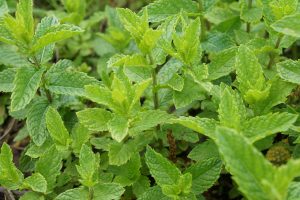
Here’s how you can use the smell of mint plants to help deter gnats:
1. Plant Mint in Your Garden: Mint is a hardy herb that can be planted in your garden or yard. It’s known for its vigorous growth, so it can spread quickly. Plant mint in an area where you want to deter gnats and where it can get partial to full sunlight.
2. Potted Mint Plants: To prevent mint from spreading uncontrollably in your garden, consider growing it in pots or containers. Place these potted mint plants in outdoor seating areas, on patios, or near entrances to help repel gnats.
3. Crush the Leaves: Mint leaves release their fragrance when crushed or brushed against. Gently crush or rub the leaves to release the aromatic oils that gnats find unappealing.
4. Mint Essential Oil: You can use mint essential oil, such as peppermint or spearmint oil, to create DIY gnat-repelling sprays as well.
5. Mint Bouquets: Create small bouquets of fresh mint sprigs and place them in vases or containers in your outdoor living areas. These bouquets will not only help deter gnats but also add a refreshing fragrance.
6. Mint Potpourri: Make potpourri using dried mint leaves and flowers or mix dried mint with other aromatic herbs and flowers. Display the potpourri in bowls around your home or outdoor spaces to repel gnats and enjoy the minty scent.
Mint is not only effective at repelling gnats but is also a versatile herb for culinary use and herbal teas. Be aware that mint has a tendency to spread aggressively, so it may be a good idea to grow it in containers if you want to control its growth in your garden. Additionally, combining mint with other gnat-repelling plants and methods can provide comprehensive protection against gnats and create a more pleasant outdoor environment.
6. Marigold: Marigold plants are known for their vibrant flowers and their ability to repel various insects, including gnats.
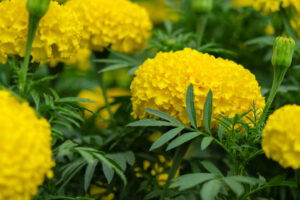
Here’s how you can use marigold plants to help deter gnats:
1. Plant Marigolds in Your Garden: Marigolds are easy-to-grow annual flowers that you can plant in your garden or yard. They have a strong scent that many insects, including gnats, find unappealing. Marigolds require full sun and well-drained soil.
2. Marigold Borders: Consider planting marigolds as a border around your garden or in areas where you want to deter gnats. Their bright flowers can add a pop of color while acting as a natural insect repellent.
3. Potted Marigold Plants: If you have limited garden space, grow marigolds in pots or containers. Place these potted marigold plants on your patio, balcony, or near outdoor seating areas to help keep gnats away.
4. Marigold Companion Planting: Marigolds are often used as companion plants in vegetable gardens because they can deter a variety of garden pests. Plant marigolds alongside vegetables and other plants to protect them from gnats and other flying insects.
5. Deadhead Spent Flowers: Removing spent marigold flowers (deadheading) can encourage the plant to produce more blooms and, consequently, release more of its scent to repel gnats.
While marigolds can be effective at repelling gnats, it’s essential to note that their effectiveness may vary depending on the specific species of gnats and environmental conditions. Combining marigolds with other gnat-repelling plants and methods, as mentioned in previous responses, can provide more comprehensive protection against gnats and create a more enjoyable outdoor environment.
7. Catnip: Catnip (Nepeta cataria) is a plant known for its ability to attract and excite cats due to the compound nepetalactone it contains. While catnip is primarily grown for feline enjoyment, it can also serve as a natural repellent for some insects, including gnats. This is definitely not a plant you want to use if you are having a problem with stray or feral cats. If you are trying to repel cats be sure to read What Plants Repel Cats here.
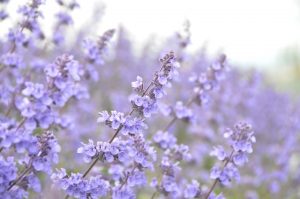
Here’s how you can use catnip to help deter gnats:
1. Plant Catnip in Your Garden: Catnip is a hardy perennial herb that can be planted in your garden or yard. It produces small, lavender-colored flowers and has a distinctive minty scent that can help repel gnats.
2. Potted Catnip Plants: If you have limited garden space or want to use catnip as a gnat repellent on your patio or balcony, grow it in pots or containers. Place these potted catnip plants near outdoor seating areas to help keep gnats away.
3. Crush the Leaves: Gently crush or rub the catnip leaves to release the nepetalactone compound and enhance its gnat-repelling properties.
4. Catnip Bouquets: Create small bouquets of fresh catnip sprigs and place them in vases or containers in your outdoor living areas. These bouquets can act as natural gnat repellents and also add a unique fragrance to your space.
5. Catnip Sachets: Make sachets using dried catnip leaves and flowers and place them around your home or outdoor areas to deter gnats.
While catnip can be effective at repelling gnats and other insects, its effectiveness may vary depending on the specific species of gnats and environmental conditions. Combining catnip with other gnat-repelling plants and methods can provide more comprehensive protection against gnats and create a more pleasant outdoor environment.
8. Lemon balm: Lemon balm (Melissa officinalis) is a fragrant herb known for its pleasant lemony scent and calming properties. While it may not be as well-known as some other plants for repelling insects, it can help deter gnats and other flying insects due to its strong aroma.
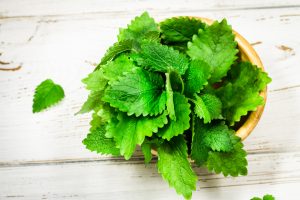
Here’s how you can use lemon balm to help repel gnats:
1. Plant Lemon Balm in Your Garden: Lemon balm is a perennial herb that you can plant in your garden or yard. It prefers partial to full sunlight and well-drained soil. The lemony fragrance released by lemon balm can help keep gnats away from the area where it’s planted.
2. Potted Lemon Balm Plants: If you have limited garden space or want to use lemon balm in specific outdoor areas, grow it in pots or containers. Place potted lemon balm plants on your patio, balcony, or near outdoor seating areas to deter gnats.
3. Crush the Leaves: Lemon balm leaves release their lemony fragrance when crushed or brushed against. Gently crush or rub the leaves to release the aromatic oils that gnats find unappealing.
4. Lemon Balm Essential Oil: You can use lemon balm essential oil to create DIY gnat-repelling sprays.
5. Lemon Balm Bouquets: Create small bouquets of fresh lemon balm sprigs and place them in vases or containers in your outdoor living areas. These bouquets can act as natural gnat repellents and also add a refreshing fragrance.
6. Lemon Balm Potpourri: Make potpourri using dried lemon balm leaves and flowers, or mix dried lemon balm with other aromatic herbs and flowers. Display the potpourri in bowls around your home or outdoor spaces to repel gnats and enjoy the lemony scent.
While lemon balm can be effective at repelling gnats, especially when its leaves are crushed to release the scent, it may not provide complete protection on its own. Combining lemon balm with other gnat-repelling plants and methods can provide more comprehensive protection against gnats and create a more enjoyable outdoor environment.
9. Lemongrass: Lemongrass (Cymbopogon citratus) is a popular plant known for its strong citrusy scent, and it can be an effective natural repellent against gnats and other flying insects.
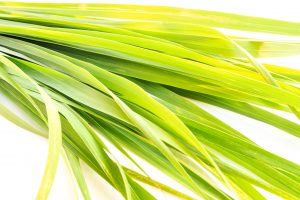
Here’s how you can use lemongrass to help deter gnats:
1. Plant Lemongrass in Your Garden: Lemongrass is a tall, grass-like plant that you can plant in your garden or yard. It requires full sun and well-drained soil. The lemony fragrance it emits can help keep gnats away from the area where it’s planted.
2. Potted Lemongrass Plants: If you have limited garden space or want to use lemongrass in specific outdoor areas, grow it in pots or containers. Place potted lemongrass plants on your patio, balcony, or near outdoor seating areas to deter gnats.
3. Crush the Leaves: Lemongrass leaves release their lemony fragrance when crushed or brushed against. Gently crush or rub the leaves to release the aromatic oils that gnats find unappealing.
4. Lemongrass Essential Oil: You can use lemongrass essential oil to create DIY gnat-repelling sprays.
5. Lemongrass Bouquets: Create small bouquets of fresh lemongrass stalks and place them in vases or containers in your outdoor living areas. These bouquets can act as natural gnat repellents and also add a refreshing citrus fragrance.
6. Lemongrass Incense: Lemongrass incense sticks or coils can be used to repel gnats and other pests during outdoor activities. Place them in appropriate holders around your outdoor space.
Lemongrass is known for its effectiveness in repelling gnats, mosquitoes, and other flying insects. By incorporating lemongrass into your garden or outdoor spaces and using its fragrance in various forms, you can help create a more pleasant and gnat-free environment.
Insect-Repelling Plants
10. Sage: Sage (Salvia officinalis) is a fragrant herb that is primarily grown for culinary and medicinal purposes, but it can also help repel gnats and other flying insects due to its strong scent.
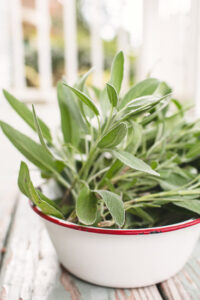
Here’s how you can use sage plants to help deter gnats:
1. Plant Sage in Your Garden: Sage is a hardy perennial herb that can be planted in your garden or yard. It prefers full sun and well-drained soil. The aromatic foliage of sage will help keep gnats away from the area where it’s planted.
2. Potted Sage Plants: If you have limited garden space or want to use sage as a gnat repellent in specific outdoor areas, grow it in pots or containers. Place potted sage plants on your patio, balcony, or near outdoor seating areas to deter gnats.
3. Crush the Leaves: Sage leaves release their fragrance when crushed or brushed against. Gently crush or rub the leaves to release the aromatic oils that gnats find unappealing.
4. Sage Essential Oil: You can use sage essential oil to create DIY gnat-repelling sprays.
5. Sage Bouquets: Create small bouquets of fresh sage sprigs and place them in vases or containers in your outdoor living areas. These bouquets can act as natural gnat repellents and also add a pleasant fragrance.
6. Sage Smudge Sticks: Sage smudge sticks are bundles of dried sage leaves that are often used in spiritual or cleansing rituals. Burning a sage smudge stick outdoors can release the sage’s aroma and help repel gnats.
7. Sage Potpourri: Make potpourri using dried sage leaves and flowers, or mix dried sage with other aromatic herbs and flowers. Display the potpourri in bowls around your home or outdoor spaces to repel gnats and enjoy the sage scent.
While sage can be effective at repelling gnats and other insects, its effectiveness may vary depending on the specific species of gnats and environmental conditions. Combining sage with other gnat-repelling plants and methods can provide more comprehensive protection against gnats and create a more enjoyable outdoor environment.
11. Thyme: Thyme (Thymus spp.) is a versatile herb known for its culinary uses and aromatic properties. It can also help repel gnats and other flying insects due to its strong scent.
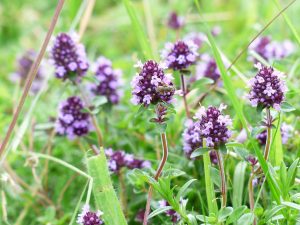
Here’s how you can use thyme plants to help deter gnats:
1. Plant Thyme in Your Garden: Thyme is a perennial herb that you can plant in your garden or yard. It thrives in full sun and well-drained soil. The aromatic foliage of thyme can help keep gnats away from the area where it’s planted.
2. Potted Thyme Plants: If you have limited garden space or want to use thyme as a gnat repellent in specific outdoor areas, grow it in pots or containers. Place potted thyme plants on your patio, balcony, or near outdoor seating areas to deter gnats.
3. Crush the Leaves: Thyme leaves release their fragrance when crushed or brushed against. Gently crush or rub the leaves to release the aromatic oils that gnats find unappealing.
4. Thyme Essential Oil: You can use thyme essential oil to create DIY gnat-repelling sprays. It’s really easy to make your own homemade gnat repellents.
5. Thyme Bouquets: Create small bouquets of fresh thyme sprigs and place them in vases or containers in your outdoor living areas. These bouquets can act as natural gnat repellents and also add a pleasant fragrance.
6. Thyme Potpourri: Make potpourri using dried thyme leaves and flowers, or mix dried thyme with other aromatic herbs and flowers. Display the potpourri in bowls around your home or outdoor spaces to repel gnats and enjoy the thyme scent.
Thyme is known for its effectiveness in repelling gnats, mosquitoes, and other flying insects. By incorporating thyme into your garden or outdoor spaces and using its fragrance in various forms, you can help create a more pleasant and gnat-free environment.
12. Oregano: Oregano (Origanum vulgare) is a flavorful herb commonly used in cooking, but it also has aromatic properties that can help repel gnats and other flying insects.
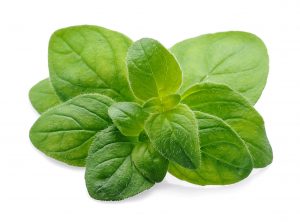
Here’s how you can use oregano plants to help deter gnats:
1. Plant Oregano in Your Herb Gardens: Oregano is a hardy perennial herb that can be planted in your garden or yard. It prefers full sun and well-drained soil. The aromatic foliage of oregano can help keep gnats away from the area where it’s planted.
2. Potted Oregano Plants: If you have limited garden space or want to use oregano as a gnat repellent in specific outdoor areas, grow it in pots or containers. Place potted oregano plants on your patio, balcony, or near outdoor seating areas to deter gnats.
3. Crush the Leaves: Oregano leaves release their fragrance when crushed or brushed against. Gently crush or rub the leaves to release the aromatic oils that gnats find unappealing.
4. Oregano Bouquets: Create small bouquets of fresh oregano sprigs and place them in vases or containers in your outdoor living areas. These bouquets can act as natural gnat repellents and also add a pleasant fragrance.
6. Oregano Potpourri: Make potpourri using dried oregano leaves and flowers, or mix dried oregano with other aromatic herbs and flowers. Display the potpourri in bowls around your home or outdoor spaces to repel gnats and enjoy the oregano scent.
While oregano can be effective at repelling gnats and other insects, its effectiveness may vary depending on the specific species of gnats and environmental conditions. Combining oregano with other gnat-repelling plants and methods can provide more comprehensive protection against gnats and create a more enjoyable outdoor environment.
13. Bee Balm (Monarda): Bee Balm also known as bergamot or wild bergamot, is a flowering perennial plant known for attracting pollinators like bees and butterflies with its vibrant blooms and fragrant leaves. While it’s primarily cultivated for its ornamental and wildlife-friendly qualities, bee balm’s strong aroma may also help deter gnats and other flying insects to some extent.
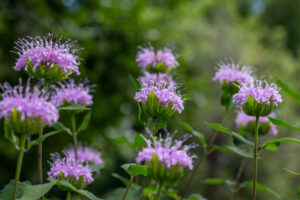
Here’s how you can use bee balm to help repel gnats:
1. Plant Bee Balm in Your Garden: Bee balm is an attractive addition to gardens and can be planted in your garden or yard. It prefers full sun to partial shade and well-drained soil. The aromatic leaves and flowers can potentially help keep gnats away from the area where it’s planted.
2. Bee Balm Bouquets: Create small bouquets of fresh bee balm flowers and place them in vases or containers in your outdoor living areas. These bouquets can act as natural gnat repellents and also add a pop of color to your space.
3. Crush the Leaves: Like many aromatic plants, bee balm leaves release their fragrance when crushed or brushed against. Gently crush or rub the leaves to release the aromatic oils that gnats may find unappealing.
4. Bee Balm Sachets: Make sachets using dried bee balm leaves and flowers and place them around your home or outdoor areas to deter gnats and add a pleasant fragrance.
While bee balm can potentially help repel gnats, its effectiveness in this regard may be limited compared to other plants specifically known for their gnat-repelling properties. Combining bee balm with other gnat-repelling plants and methods, as mentioned in previous responses, can provide more comprehensive protection against gnats and create a more enjoyable outdoor environment.
14. Pennyroyal: Pennyroyal (Mentha pulegium), a member of the mint family, is sometimes suggested as a natural repellent for various insects, including gnats and mosquitoes, due to its strong minty scent.
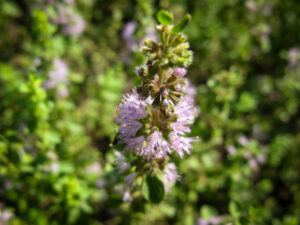
However, there are some important considerations and precautions when using pennyroyal:
1. Plant Pennyroyal in Your Garden: Pennyroyal is a low-growing herbaceous plant that can be planted in your garden or yard. It prefers full sun to partial shade and well-draining soil.
2. Pennyroyal Sachets: Create sachets using dried pennyroyal leaves and flowers and place them around your home or outdoor areas to deter gnats and other insects.
3. Pennyroyal Potpourri: Make potpourri using dried pennyroyal leaves and flowers, or mix dried pennyroyal with other aromatic herbs and flowers. Display the potpourri in bowls around your home or outdoor spaces to repel gnats and enjoy the minty scent.
It’s important to note that while pennyroyal is known for its potential insect-repelling properties, it contains a compound called pulegone, which can be toxic in high doses. Pennyroyal should be used with caution, and its essential oil should be used sparingly and diluted properly.
Additionally, pregnant individuals and individuals with certain medical conditions should avoid using pennyroyal due to its potential toxicity.
Given these considerations, you may want to explore other gnat-repelling plant options, such as those mentioned earlier, that are safer and more widely recognized for their effectiveness in repelling gnats without the associated risks of pennyroyal.
Remember that while these plants can help deter gnats, they may not provide complete protection on their own. It’s often most effective to use a combination of methods, including planting a variety of plants, using essential oils, and employing other gnat control strategies such as those listed below for the best results.
Additional Ways to Repel Gnats
In addition to planting the gnat-repelling plants and using the essential oils listed above, there are several other methods you can use to repel gnats:
2. Gnat Traps: Set up gnat traps around your home and outdoor spaces. You can make DIY traps using apple cider vinegar, sugar, and dish soap in a small container. Gnats are attracted to the scent of the vinegar and get trapped in the soapy mixture.
3. Screens and Netting: Install screens on windows and doors to keep gnats from entering your home. For outdoor areas like patios and decks, consider using mosquito netting or screens to create a barrier between you and the gnats.
4. Fans: Use electric fans in outdoor areas where you spend time. Gnats are weak fliers, and a gentle breeze can make it difficult for them to approach you.
5. Avoid Sweet Scents: Gnats are attracted to sweet scents, so avoid using heavily scented perfumes, lotions, or hair products when you’re spending time outdoors.
6. Wear Light-Colored Clothing: Gnats are attracted to dark colors, so wearing light-colored clothing can make you less appealing to them.
7. Keep Food Covered: When dining outdoors, use food covers or cloths to protect your food from gnats and other flying insects.
8. Eliminate Breeding Sites: Gnats lay their eggs in damp, decaying organic matter. Eliminate potential breeding sites by keeping compost bins covered and removing rotting fruit or vegetation from your yard.
9. Repellent Sprays: Consider using natural insect repellent sprays designed to repel gnats. You can find a great gnat spray here.
10. Outdoor Citronella Candles: Citronella candles and torches can create a protective barrier of scent to keep gnats away from outdoor gathering areas.
11. Avoid Overwatering Plants: Overwatered soil can attract gnats. Ensure proper drainage for your potted plants and avoid letting water accumulate in saucers.
12. Natural Predators: Attract natural predators of gnats, such as dragonflies to help keep the gnat population down.
By combining these methods with gnat-repelling plants, you can significantly reduce the presence of gnats in your outdoor and indoor spaces and enjoy a more comfortable environment.
Plants That Repel
If you are looking to repel other animals from your yard and garden be sure to check out:

